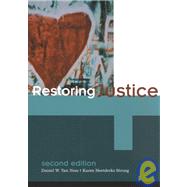| Foreword | iii | ||||
| Part One The Vision of Restorative Justice | 1 | (52) | |||
|
3 | (12) | |||
|
7 | (6) | |||
|
13 | (2) | |||
|
15 | (22) | |||
|
16 | (11) | |||
|
16 | (2) | |||
|
18 | (2) | |||
|
20 | (1) | |||
|
21 | (3) | |||
|
24 | (3) | |||
|
27 | (1) | |||
|
28 | (4) | |||
|
32 | (3) | |||
|
35 | (2) | |||
|
37 | (16) | |||
|
43 | (2) | |||
|
45 | (4) | |||
|
49 | (4) | |||
| Part Two The Values of Restorative Justice | 53 | (100) | |||
|
55 | (24) | |||
|
57 | (4) | |||
|
61 | (2) | |||
|
63 | (3) | |||
|
66 | (2) | |||
|
68 | (3) | |||
|
71 | (6) | |||
|
71 | (1) | |||
|
72 | (5) | |||
|
77 | (2) | |||
|
79 | (20) | |||
|
82 | (1) | |||
|
83 | (1) | |||
|
84 | (1) | |||
|
84 | (1) | |||
|
85 | (1) | |||
|
86 | (4) | |||
|
90 | (4) | |||
|
91 | (1) | |||
|
92 | (2) | |||
|
94 | (2) | |||
|
96 | (3) | |||
|
99 | (24) | |||
|
102 | (2) | |||
|
104 | (2) | |||
|
106 | (4) | |||
|
110 | (10) | |||
|
110 | (3) | |||
|
113 | (7) | |||
|
120 | (3) | |||
|
123 | (30) | |||
|
125 | (2) | |||
|
127 | (4) | |||
|
127 | (2) | |||
|
129 | (1) | |||
|
130 | (1) | |||
|
131 | (2) | |||
|
133 | (7) | |||
|
136 | (4) | |||
|
140 | (1) | |||
|
141 | (2) | |||
|
142 | (1) | |||
|
143 | (3) | |||
|
143 | (1) | |||
|
144 | (1) | |||
|
145 | (1) | |||
|
146 | (4) | |||
|
146 | (4) | |||
|
150 | (3) | |||
| Part Three The Venture Toward Restorative Justice | 153 | (98) | |||
|
156 | (29) | |||
|
156 | (3) | |||
|
159 | (4) | |||
|
163 | (2) | |||
|
165 | (3) | |||
|
168 | (4) | |||
|
172 | (4) | |||
|
176 | (4) | |||
|
180 | (1) | |||
|
181 | (4) | |||
|
185 | (20) | |||
|
186 | (5) | |||
|
191 | (3) | |||
|
194 | (2) | |||
|
196 | (2) | |||
|
198 | (4) | |||
|
202 | (3) | |||
|
205 | (16) | |||
|
205 | (3) | |||
|
208 | (1) | |||
|
209 | (4) | |||
|
213 | (3) | |||
|
216 | (1) | |||
|
217 | (1) | |||
|
217 | (1) | |||
|
218 | (2) | |||
|
220 | (1) | |||
|
221 | (18) | |||
|
221 | (3) | |||
|
224 | (2) | |||
|
226 | (2) | |||
|
228 | (9) | |||
|
237 | (2) | |||
|
239 | (12) | |||
|
241 | (4) | |||
|
245 | (2) | |||
|
247 | (4) | |||
| Appendix | 251 | (22) | |||
|
253 | (8) | |||
|
261 | (6) | |||
|
267 | (6) | |||
| Selected Bibliography | 273 | (24) | |||
| Subject Index | 297 | (12) | |||
| Name Index | 309 |








